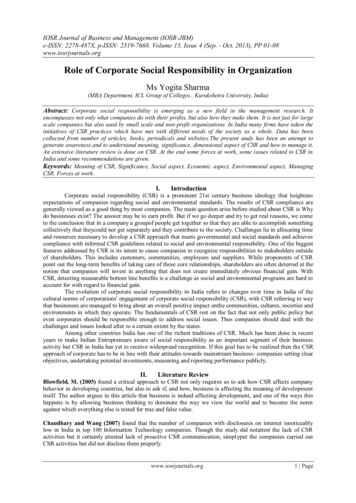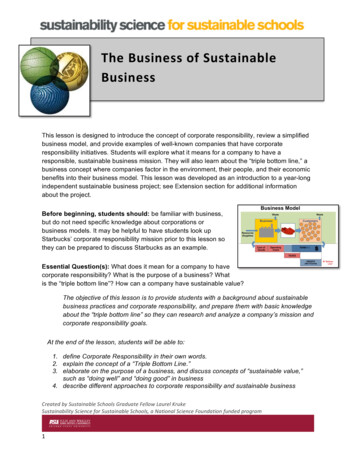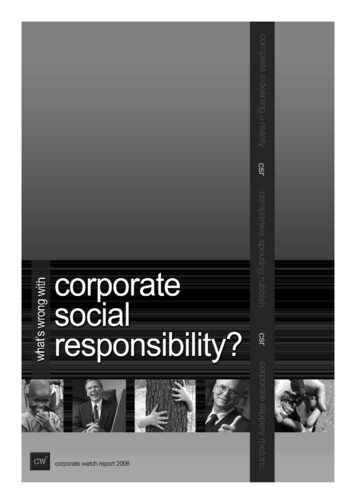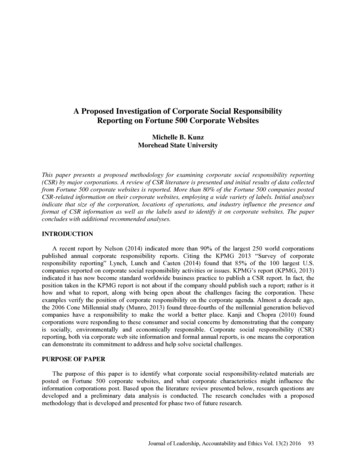
Transcription
IOSR Journal of Business and Management (IOSR-JBM)e-ISSN: 2278-487X, p-ISSN: 2319-7668. Volume 13, Issue 4 (Sep. - Oct. 2013), PP 01-08www.iosrjournals.orgRole of Corporate Social Responsibility in OrganizationMs Yogita Sharma(MBA Department, ICL Group of Colleges , Kurukshetra University, India)Abstract: Corporate social responsibility is emerging as a new field in the management research. Itencompasses not only what companies do with their profits, but also how they make them. It is not just for largescale companies but also used by small scale and non-profit organizations. In India many firms have taken theinitiatives of CSR practices which have met with different needs of the society as a whole. Data has beencollected from number of articles, books, periodicals and websites.The present study has been an attempt togenerate awareness and to understand meaning, significance, dimensional aspect of CSR and how to manage it.An extensive literature review is done on CSR. At the end some forces at work, some issues related to CSR inIndia and some recommendations are given.Keywords: Meaning of CSR, Significance, Social aspect, Economic aspect, Environmental aspect, ManagingCSR, Forces at work.I.IntroductionCorporate social responsibility (CSR) is a prominent 21st century business ideology that heightensexpectations of companies regarding social and environmental standards. The results of CSR compliance aregenerally viewed as a good thing by most companies. The main question arise before studied about CSR is Whydo businesses exist? The answer may be to earn profit. But if we go deeper and try to get real reasons, we cometo the conclusion that in a company a groupof people get together so that they are able to accomplish somethingcollectively that theycould not get separately and they contribute to the society. Challenges lie in allocating timeand resources necessary to develop a CSR approach that meets governmental and social standards and achievescompliance with informal CSR guidelines related to social and environmental responsibility. One of the biggestfeatures addressed by CSR is its intent to cause companies to recognize responsibilities to stakeholders outsideof shareholders. This includes customers, communities, employees and suppliers. While proponents of CSRpoint out the long-term benefits of taking care of these core relationships, shareholders are often deterred at thenotion that companies will invest in anything that does not create immediately obvious financial gain. WithCSR, detecting measurable bottom line benefits is a challenge as social and environmental programs are hard toaccount for with regard to financial gain.The evolution of corporate social responsibility in India refers to changes over time in India of thecultural norms of corporations' engagement of corporate social responsibility (CSR), with CSR referring to waythat businesses are managed to bring about an overall positive impact onthe communities, cultures, societies andenvironments in which they operate. The fundamentals of CSR rest on the fact that not only public policy buteven corporates should be responsible enough to address social issues. Thus companies should deal with thechallenges and issues looked after to a certain extent by the states.Among other countries India has one of the richest traditions of CSR. Much has been done in recentyears to make Indian Entrepreneurs aware of social responsibility as an important segment of their businessactivity but CSR in India has yet to receive widespread recognition. If this goal has to be realized then the CSRapproach of corporate has to be in line with their attitudes towards mainstream business- companies setting clearobjectives, undertaking potential investments, measuring and reporting performance publicly.II.Literature ReviewBlowfield, M. (2005) found a critical approach to CSR not only requires us to ask how CSR affects companybehavior in developing countries, but also to ask if, and how, business is affecting the meaning of developmentitself. The author argues in this article that business is indeed affecting development, and one of the ways thishappens is by allowing business thinking to dominate the way we view the world and to become the normagainst which everything else is tested for true and false value.Chaudhary and Wang (2007) found that the number of companies with disclosures on internet isnoticeablylow in India in top 100 Information Technology companies. Though the study did notattest the lack of CSRactivities but it certainly attested lack of proactive CSR communication, simplyput the companies carried outCSR activities but did not disclose them properly.www.iosrjournals.org1 Page
Role Of Corporate Social Responsibilityin OrganizationHossain and Reaz (2007) investigated the extent of voluntary disclosures by 38 listed bankingcompanies inIndia. The empirical research concluded that the size and assets were the significantfactors influencingdisclosure whereas age, diversification, board composition and multiple exchangelisting and complexity ofbusiness are not significant variables influencing social reporting practicesof Indian banking companies.Murthy (2008) examined the corporate social disclosure practices of the top 16 software firms inIndia. The2003–2004 annual reports were analyzed using content analysis and it was found that thehuman resources wasthe most frequently reported followed by community development activitiesand the environmental activities wasthe least reported. Most of the information was qualitative andwas disclosed in the „other‟ sections of the annualreport. Some firms had separate sections for eachcategory while many others disclosed their social practices inthe introductory pages of the annualreport. The researcher suggested that shortage of skilled labor in thesoftware sector might have leadto social disclosure (CSD) practices in the human resources. Firms seemed tohave engaged incommunity development activities without expecting changes to their economic performanceand theCSD of community activities seemed to be shaped by the expectations of the society.Jatana and Crowther (2008) edited book named “Corporate social responsibility – theory and practicewithcase studies” has shed light on myths of Corporate social responsibility, value addition,Globalization perspectives on corporategovernance whistle blowing policies as corporate socialresponsibilityand other contemporary issues in corporate social responsibility. In addition, it dealtwith various case studiesrelated to various industrial sectors insurance, private banking, SMEs,Information Technology, powergeneration sectors and companies like Abuja cements, Coca- Cola.In all these articles details of current projectspursed by companies has given but the CSRD has notbeen measured as such.Plankenet al (2010) investigated CSR platforms and the communication surrounding those platformsin Indiaand established that the CSR platforms are typically used, together with stakeholder attitudesto both the formand content of those platforms. The authors presented the fact that the selected Indiancorporations pursued aprimarily philanthropic platform with a focus on community developmentprojects, as predicted by previousstudies. It also indicated, however, that Indian consumers may notvalue philanthropic CSR as highly as otherCSR initiatives.III.MethodologyThe prepared paper is a descriptive study in nature. The secondary data and informationhave beenanalyzed for preparing the paper extensively. The secondary information havebeen collected from differentscholars‟ and researchers‟ published books, articlespublished in different journals, periodicals, conference paper,working paper and websites.Dimensions of CSRThe three dimensional aspect of corporate social responsibility (CSR) includes : Economic aspects. Social aspects. Environmental aspects.1. Economic aspects of CSRThe economic aspects of CSR consist of understanding the economic impacts of thecompany‟soperations. The economic aspects of CSR is often mistakenly considered to be synonymous withfinancial issues,which is why it has been assumed easier to implement than the other twopillars of the temple. However, theeconomic responsibility is not simply a matter ofcompanies being financially accountable, recordingemployment figures and debts intheir latest corporate responsibility report. The economic dimension of thewww.iosrjournals.org2 Page
Role Of Corporate Social Responsibilityin Organizationsustainabilityagenda should rather consider the direct and indirect economic impacts that theorganization‟soperations have on the surrounding community and on the company‟sstakeholders. That is what makes upcorporate economic responsibility.a) Effect on StakeholdersThe economic performance of a company has direct and indirect impacts on all of itsstakeholders –including its employees, local governments, non-profit organizations,customers, suppliers, and the communitiesin which the companies operates. A good economic performance makes it possible to develop operations for thelong term and to invest in development and the well-being of employees. The employees of the company getgood salaries, from which they purchase goods and services as well as pay taxes. These activities fuel the localservice industry, government programs and the community activities. This multiplier effect becomes all themore important if thecompany is one of the largest employers in the communities.b) Through taxesCompanies are major contributors to the well-being of the area surrounding theiroperations, forexample through the local tax base. Therefore, the question arises: is itresponsible for a business to see corporatetaxes purely as to cost be avoided, rather thanpart of their social contract with society? Taxes have a significantimpact on the creationand distribution of wealth: tax avoidance, though perfectly legal, deprives thecommunityin the area of the company‟s operation of well-being.c) Maintaining TrustA company‟s license to operate depends upon the trust and support of the localcommunities where itoperates. The shift in power from the public the private sectoremphasizes the importance of this trust – and theobligations and responsibilities thatcome with it. Some company activities are potentially very destructive to thetrust earnedfrom the community or otherwise cannot be regarded as economically responsible. Theseshould beavoided or at least carefully considered. Example of such harmful companybehavior include: bribery andcorruption, tax avoidance: and concentration of rewardsand incentives of the company‟s performance to fewindividuals only instead of fairerdistribution among the personnel. The company should also stop to considertheeconomic effects of changes in locations and/or operations to the community.2. Social Aspects of CSRSocial responsibility is the newest of the three dimensions of corporate socialresponsibility and it isgetting more attention than it has previously had. Manyorganizations are becoming increasingly active inaddressing social concerns socialresponsibility means being accountable for the social effects the company hason people -even indirectly. This includes the people within the company, in the supply chain of thecompany, inthe community the company is in and as customers of the company whichmeans the whole lot of stakeholder. Itrefers to the management‟s obligation to makechoices and take actions that will contribute to the well fare andinterests of society aswell as those of the organization. The following aspects have been found to be keythesocial aspects of CSR for an organization.a) Responsibility of CSR towards CustomersThe idea of treating customers with respect and attention is not new to business: oftenbeing responsibleto customers has a direct positive effect on the company‟s profits.There are, however, broader socialresponsibilities including providing good value formoney. These responsibilities may include such issues as thesafety and durability ofproducts or services; standard or after sales service; prompt and courteous attentiontoqueries and complaints; adequate supply of products or services; fair standards ofadvertising and trading; andfull and unambiguous information to potential customers.b) Responsibilityof CSR towards EmployeesBusinesses are major contributors to the employment generation of the community.However, socialresponsibility to employees extends beyond terms and conditions of theformal contract of employment.Companies need to come up with wider expectations thattoday‟s employees have for the quality of theirworking life. Such expectations includetaking care of the personnel‟s welfare and safety at work and upholdingtheir skills andmotivation for the work. Beyond these expectations, a socially responsible companysecures a justtreatment and equal opportunities for all its employees, regardless ofgender, age, race, or religion.c) Responsibility of CSR towards the CommunityCompanies depend on the health, stability, and prosperity of the communities in whichthey operate.Often majority of the company‟s employees and customers come from thesurroundings area – especially so forwww.iosrjournals.org3 Page
Role Of Corporate Social Responsibilityin OrganizationSME‟s. The reputation of a company at it s location,its image as an employer and producer, but also as an actorin the local scene, certainlyinfluences its competitiveness. Many companies become involved in communitycauses,for example by providing additional vocational training places, recruiting sociallyexcluded people,sponsoring local sports and cultural events, and through partnershipswith communities or donations to charitableactivities.3. Environmental aspects of CSREnvironmental concern and sustainable development is a key pillar of the corporatesocialresponsibility. Environmental and ecological issues have been an important topic ofdiscussion for the pastthirty years in the business world – the longest time of the threedimensions corporate social responsibility. Theknowledge and issues within thedimensions have progressed across a landscape of changing businessrealities.Environmental aspects put in place in the 1970s with the first real understanding of theenvironmentalimpacts of business.a) Environmental ImpactCorporate activity may have many types of effect s on the environment. Usuallyenvironmental impactrefers to the negative effects occurring in the surrounding naturalenvironmental due to business operations. Suchimpacts may include: overuse of natural,non-renewable resources of energy, pollution wastage, degeneration ofbiodiversity,climate change, deforestation etc. Since many business – related environmental problemtranscendnational boundaries, most companies s are thus actors in global environment.b) Measuring Environmental ImpactEnvironmental impacts can be measured in severalways through environmentally extended inputoutput tables, material input per serviceunit (MIPS) calculations, ecological footprint and life cycle assessment,to name a few.Ecological footprint measures the amount of nature‟s resources consumed in a givenyear, andcompares it to the resources available in the world. Life cycle assessment (LCAor eco-balance) is used to assessthe environmental performance of a product from rawmaterials in the beginning of the production process all theway to disposal at the end ofuse. The MIPS value is calculated by dividing the amount of material the productorservice causes to movee.g. the amount of earth moved in mining , not just the metalused – during its entire life– span by the amount of benefits and value its brings.c) Environmental ManagementTo truly commit to its environmental responsibilities acompany should change its traditional modesoperation towards a more environmentallyoriented one. The environmentally more responsible perspectivecould include suchissues as an emphasis on increased resource productivity, cleaner production andactivedialogue with the company‟s stakeholders. Many businesses have found that establishingan environmentalmanagement system is the best basis for good environmentalperformance. Quality, health and safety issues canalso be integrated into the samemanagement system.d) Environmental ResponsibilitySeveral individual companies have found that improving environmental performancemay also havebeneficial effects on the company itself. Using less material andstreamlining processes to create less waste maylower the costs of operation significantly.Moreover, the close review of operations, which is needed to improvethe environmentalperformance, may reveal other improvement points, such as risk and material loss.Aresponsible public image may also attract more customers. State governments can fulfill their role in helpingbusiness to identify marketopportunities and undertake win-win investments, the action program also set outanumber of other measures aimed at business: establishment of a compliance assistanceprogram to help businessunderstand the environmental requirements of the EuropeanCommunity; development of national, butharmonized, company environmentalperformance reward schemes that identify and reward good performers andencouragevoluntary commitments and agreements.Significance of CSR: CSR plays very significant role in smooth functioning of organizations. It includes:a) Social Responsibility and Customer RelationshipsOne of the foundational elements of CSR is that it causes companies to reason beyond basic ethics toconsider the benefits of active involvement in communities. In his article "The 7 Principles of BusinessIntegrity," business strategist Robert Moment argues that 21st-century companies must prove themselves towww.iosrjournals.org4 Page
Role Of Corporate Social Responsibilityin Organizationcustomers to build long-term, trusting relationships. They must also get involved in the community to give back.This community connection endears your company to the local markets in which you operate.b) Motivated EmployeesEmployees are a company's most valued asset. This is the premise of a company's obligation to this keystakeholder group with regard to CSR compliance. This means treating employees with respect and offering fairworking conditions. It also means establishing fair hiring practices and promoting a non-discriminatoryworkplace. This improves morale within the workplace and encourages teamwork.c) Profitability and ValueA CSR policy improves company profitability and value. The introduction of energy efficiencies andwaste recycling cuts operational costs and benefits the environment. CSR also increases company accountabilityand its transparency with investment analysts and the media, shareholders and local communities. This in turnenhances its reputation among investors such as mutual funds that integrate CSR into their stock selection. Theresult is a virtuous circle where the company's stock value increases and its access to investment capital is eased.d) Showing a True CommitmentThe most successful corporate social responsibility programs integrate these two types of CSRtogether to show a true commitment to a cause. For example, a company that uses sustainable materials in theirproducts, donates financial resources to environmental causes, and allows employees to take paid time off forvolunteering at environmental charities would be showing a true commitment to the environment that goesbeyond any single CSR initiative.e)Social Media VisibilityOne of the reasons that corporations should have visible CSR campaigns is due to the importance andprevalence of social media. Corporations that want to protect their brand understand that social media is anintegral part of public perception. When a corporation exercises social responsibility in the form of fundraisingor setting up employee giving programs, using social media to promote these actions helps to create a positivebranding environment and it is a great way to engage with your audience on a deeper level that goes beyondyour products or services.f) Public Relations BenefitsPublic relations are a potent tool for shaping consumer perception and building a company‟s image.Corporations that actively promote their social responsibility activities often take steps to publicize these effortsthrough the media. Getting the word out about corporate donations, employee volunteer programs, or other CSRinitiatives is a powerful branding tool that can build publicity for you in both online and print media.g) Government RelationsCorporations that place an emphasis on corporate social responsibility typically have an easierexperience when dealing with politicians and government regulators. In contrast, businesses that present areckless disregard for social responsibility tend to find themselves fending off various inquiries and probes,often brought on at the insistence of public service organizations. The more positive the public perception is thata corporation takes social responsibility seriously; the less likely it is that activist groups will launch publiccampaigns and demand government inquiries against it.h) Building a Positive Workplace EnvironmentFinally, one of the greatest benefits of promoting social responsibility in the workplace is the positiveenvironment you build for your employees. When employees and management feel they are working for acompany that has a true conscience, they will likely be more enthusiastic and engaged in their jobs. This canbuild a sense of community and teamwork which brings everyone together and leads to happier, moreproductive employees.IV.Managing For Social ResponsibilityFor managing social responsibility many steps are taken by the different companies for doingsignificant improvements in theirenvironmental and social management practices.1. Corporate GovernanceIn general, governanceis about how power, privilege, and wealth are distributed and howand by whomthey are exercised. In a corporate sense,governance involves defining a vision and the overall direction ofthefirm, setting standards, overseeing the allocation of financialand human resources, and balancing the interests ofstakeholdersor constituencies. It is increasingly recognized that governancemust also be concerned with thesustainability of the enterpriseand the values that guide decision making and the articulation andcommunicationwww.iosrjournals.org5 Page
Role Of Corporate Social Responsibilityin Organizationof the core ideology of the firm. It is concernedwith the relationships between shareholders, management,andthe Board of Directors and increasingly with other keystakeholders or constituencies.2. Organizational AlignmentLeading edge companies, those that have prospered andsurvived over time, have shown more than aclear sense ofpurpose and core values. They have also translated them intoaction and ensured that they arereflected consistently throughoutthe organization in everything the company does. They achievethis alignmentthrough: Their goals, strategies, tactics, and systems, The way they organize (structures, building, office layouts), Their human resource policies and practices, and Their day-to-day decisions.3. Audits and Accounting PracticesDuring the past ten years, a number of business networks andcompanies have engaged inenvironmental and social accounting.Several NGOs and multi-sector partnerships such asAccountAbility and the Global Reporting Initiativehavepioneered the development of standards, terminology, andaccreditation procedures for social and ethicalaccounting andauditing. These innovative approaches arebased on relatively sophisticated efforts to determinewhat isconsidered to be important for each of the stakeholders and thento define specific objectives and actionprogrammes for priorityareas of performance improvement. The annual social reportsevaluate performanceagainst these plans just as the annualfinancial reports show financial results compared to prior yearsandsometimes objectives.4. Educating for Social ResponsibilityThere is reason for some optimism about the increasing recognition of the need to build business ethics,environment, andsocial responsibility into educational programmers for businessstudents and managers. Ethicsand entrepreneurship are on theexecutive education agenda.5. Forces at WorkMost business leaders would agree that they are managing intimes of turbulence and accelerating change.They would alsofind a consensus about most of the trends and forces which arechallenging their traditionalviews of competitiveness and of thesuccess factors for survival and profitability. These forcesinclude onof markets, consumer preferences, supply chainsand financial flows. Some businessleaders considerglobalization to be a revolution, not simply a trend, since it ishaving momentous effectson the economies of all countries andon corporations in most sectors.Increasing intensity of competition. Peter Veil used theexpression „managing in white water‟ to expressthe challenge ofmeeting the turbulence and instability which global competitionhas created. It is unlikelywe will ever return to the comfortable1970‟s.Rapid technological changesare transforming markets,alleviating burdensome tasks, enabling greatercustomization ofproduction, and contributing to high labour displacement.Modern information technology makes it possible to decentralizedecision-making without losing controland to introduce moreflexible and less hierarchical structures.A shift from an industrial economy to a knowledge andinformation based economy. Human capital isreplacing financialcapital as the most important strategic resource. Traditionalconcepts of work, of jobs,and of motivation are beingchallenged.Demographic changesnot only threaten the sustainability ofour planet but create a mismatch betweenjobs and suitablytrainedworkers, and between present educational systems and theneeds of a knowledgeand information-based economy.Environmental challengescaused by pollution and resourcedepletion test the sustainability of our planetearth. Businessleaders are called upon to play an important role in meeting thesechallenges.Changing value systemsare finding expression in different lifestyles and expectations on the part ofemployees, customers, andcommunities as a whole. As the world business environment changes, so dotherequirements for success andcompetitiveness. Because of theabove forces at work, building deeperwww.iosrjournals.org6 Page
Role Of Corporate Social Responsibilityin OrganizationIX.and more strategicrelationships with customers, suppliers, employees, communitiesand otherstakeholders (the corporate eco-system) can becomecentral to competitiveness and even survival.Building theserelationships can form the foundation for a new, progressiveand people-centeredcorporate strategy which attacks thesources - not the symptoms of challenges facing businesstoday.Current State of CSR in IndiaCSR is not a new concept in India. Ever since their inception, corporate like the Tata Group, the AdityaBirla Group, and Indian Oil Corporation, to name a few have been involved in serving the community. Throughdonations and charity events, many other organizations have been doing their part for the society. The basicobjective of CSR in these days is to maximize the company's overall impact on the society and stakeholders.CSR policies, practices and programs are being comprehensively integrated by an increasing number ofcompanies throughout their business operations and processes. A growing number of corporate feel that CSR isnot just another form of indirect expense but is important for protecting the goodwill and reputation, defendingattacks and increasing business competitiveness.Companies have specialized CSR teams that formulate policies, strategies and goals for their CSRprograms and set aside budgets to fund them. These programs are often determined by social philosophy whichhave clear objectives and are well defined and are aligned with the mainstream business. The programs are putinto practice by the employees who are crucial to this process. CSR programs ranges from communitydevelopment to development in education, environment and healthcare etc.For example, a more comprehensive method of development is adopted by some corporations such asBharat Petroleum Corporation Limited, Maruti Suzuki India Limitedand Hindustan Unilever Limited. Provisionof improved medical and sanitation facilities, building schools and houses, and empowering the villagers and inprocess making them more self-reliant by providing vocational training and a knowledge of business operationsare the facilities that these corporations focus on. Many of the companies are helping other peoples by providingthem good standard of living.On the other hand, the CSR programs of corporations like GlaxoSmithKline Pharmaceuticals‟ focus onthe health aspect of the community. They set up health camps in tribal villages which offer medical check-upsand treatment and undertake health awareness programs. Some of the non-profit organizations which carry outhealth and education programs in backward areas are to a certain extent funded by such corporations.Also Corporate increasingly join hands with Non-governmental organizations (NGOs) and use their expertise indevising programs which address wider social problems.For example, a lot of work is being undertaken to rebuild the lives of the tsunami affected victims. Thisis exclusively undertaken by SAP India in partnership with Hope Foundation, an NGO that focuses mainly onbringing about improvement in the lives of the poor and needy . The SAP Labs Center of HOPE in Bangalorewas started by this venture which looks after the food, clothing, shelter and medical care of street children.CSR has gone through many phases in India. The ability to make a significant difference in the society andimprove the overall qual
At the end some forces at work, some issues related to CSR in India and some recommendations are given. Keywords: Meaning of CSR, Significance, Social aspect, Economic aspect, Environmental aspect, Managing CSR, Forces at work. I. Introduction Corporate social responsibility (CSR) is a prominent 21st century business ideology that heightens










